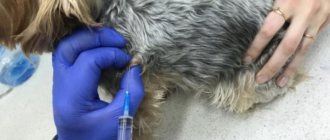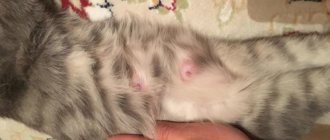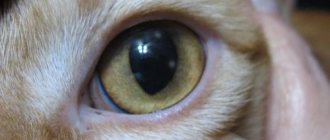If a cat scratches its neck, this condition should not be ignored, as it may indicate serious dermatological or other diseases. The appearance of bald spots behind the ears of a kitten or small crusts can also signal an allergic reaction, which does not require special treatment, it is enough to simply eliminate the irritant. When irritation is accompanied by other unpleasant symptoms or the wound bleeds, you should immediately contact a veterinarian, since delaying treatment will lead to infection and other complications dangerous to the cat’s health.
A little theory
The wound in this case is a violation of the integrity of the skin layer, affecting the underlying tissue . It can be superficial (essentially a serious scratch) or deep, affecting even the muscle layer and large vessels. In pets, such pathologies are most often the result of traumatic exposure. They occur during fights, attacks by other animals, after collisions with cyclists or cars, and also include surgical injuries that have to be inflicted on the animal during surgery. In short, there are many reasons. But in this case, it is much more important to us what happens to the wound in the future.
Its healing can occur in two types , first described by the luminary of Russian medicine, N.I. Pirogov. He distinguished between healing by primary and secondary intention. With primary intention, wounds heal only after surgery: their edges are smooth, regenerative processes start immediately. Considering that during any operation the rules of asepsis and antiseptics are strictly observed, and therefore the effect of pathogenic and conditionally pathogenic microflora is completely excluded. This happens in several stages:
- Granulation. To protect itself from the penetration of microflora and debris into the wound cavity, the body begins to “darn” the wound with granulation. Fibroblasts and endothelial cells participate in the process, and new blood vessels grow from the latter.
- Increasing the epidermal layer. Epithelial cells along the edges of the wound channel gradually begin to “slide” onto the upper surface of the granulation, forming a new layer of skin epidermis.
- Myofibroblasts also play an important role in the healing process. It is from these cells that muscle fibers subsequently develop. They play the role of a kind of “ties”, literally tightening the edges of the former wound channel.
In principle, wound healing by secondary intention proceeds similarly, but in this case pyogenic microflora interferes with the process: complete granulation of the wound canal will not occur until all dead tissue and microbes are removed from the wound along with pus and other secretions. And it is with this process that difficulties may arise...
Parasites in cats
Most often, the cause of the disease is parasites. They choose the softest and warmest places on the cat's body. For example, the neck or the area under the animal’s paws. Such parasites can be fleas and ticks. However, basically it is not they themselves that cause the disease, but the components of their vital activity. Saliva, getting under the pet's skin, triggers an allergic reaction mechanism. The cat feels itchy and scratches the bite sites. Further, bacteria enter the wounds and the already complicated course of the disease begins.
The owner of the animal first of all needs to pay attention to the restless behavior of his pet.
Carefully examine the skin and if fleas or ticks are found, treat for parasites. In any case, you need to contact a veterinary clinic. To make sure that the body’s reaction was really to parasites.
If the cat itches, but the owner does not find fleas, then perhaps the cause is ticks. Subcutaneous parasites can only be detected by a veterinarian. After performing certain tests, the doctor makes a diagnosis and prescribes treatment. Most often, cats are given Ivermek injections. Three intramuscular injections are required at intervals of ten days.
It happens that there is no opportunity to visit the veterinarian, and the cat scratches itself. In this case, you should try to purchase the same medicine, but in gel form and smear it on the animal.
What is a weeping wound, the reasons for its occurrence
This is a wound whose surface is not contracted by granulations and does not heal. It literally oozes ichor or necrotic exudate. The color and smell of the exudate resembles rotting meat slop. It is necessary to distinguish a weeping wound from an ulcer: in the first case, a skin defect occurs as a result of mechanical action, in the second it is only a consequence of some severe metabolic disorders or hormonal metabolism in the body (a good example is ulcers due to diabetes or uremia).
A cat has sores on its neck and hair is falling out: Where to go?
Saint Petersburg:
- Sotnikov Veterinary Clinic. One of the best clinics in Russia. They deal with both complex cases that require a consultation of doctors, as well as simpler ones. The clinic's doctors are lecturers at conferences aimed at improving the skills of other doctors.
- Vetnet. Specialists will make an accurate diagnosis quickly. Quality treatment will be prescribed.
- Vetus. Top-class veterinary dermatologists work here.
Moscow:
- Medea. A wide range of veterinary services from nail trimming to ultrasound. There is a hospital. Doctors make decisions quickly and efficiently, prescribe only the necessary diagnostics and treatment without frills.
- Clinic Gav. 20% discount on consultations without animals. Friendly staff. Convenient location.
- Your doctor. Renowned dermatologists provide appointments by appointment. It is possible to immediately carry out all diagnostic procedures if the pet is properly prepared. You can always find out more information by phone or on the clinic’s website.
Rostov-on-Don:
- Center. One of the best clinics in Rostov-on-Don. Visitors note the abundance of pet products in the pharmacy. They speak positively about the staff, both administrators and doctors.
- Animal friend. High-class specialists will provide quick and high-quality assistance to your pet if you contact them in a timely manner. There is a flexible system of discounts. Friendly administrators will help and explain everything.
- Veterinary clinic of Dr. Zarubin. The initial appointment is only 200 rubles. Other manipulations are performed according to the price list. The experience of doctors allows us to quickly make an accurate diagnosis and prescribe treatment.
Quantity
Diagnostics
In general, diagnosing a weeping wound does not cause any difficulties; everything is quite obvious, based on the visual signs of the pathological process. It is much more important to find out which microbe caused the inflammatory process. To answer this question, it is necessary to take a sample of pathological material from the wound and inoculate it on a nutrient medium.
In addition, it may be necessary to take blood and urine tests when there is a suspicion of the endogenous origin of a weeping wound (that is, to identify hormonal and other disorders).
Therapeutic techniques
How to treat a weeping wound on a cat? In mild cases, they resort to “open”, “dry” wound treatment. This does not mean that the damage is left open to environmental factors. Its purpose is to create the most favorable conditions for wound healing by the body itself. Sometimes a simple bandage is quite enough for healing by secondary intention, but for this to happen several factors must coincide:
- The regeneration process is progressing well.
- It is important to prevent the formation of large scars, which can impair the functionality of the damaged organ or reduce the breeding value of the animal.
- The patient tolerates the dressing without tearing it off every two minutes.
Necessary treatment
When the owners notice a spot on a cat, due to which it has severely scratched the skin, they should not delay contacting the veterinarian. After a comprehensive diagnosis, the specialist will select the necessary therapeutic measures to eliminate the problem. If wounds on the neck are associated with flea activity, then it is necessary to treat the animal’s fur and skin, and other treatment methods are also used:
- using a special collar;
- pills;
- external treatments such as shampoo, spray or powders;
- local action drops.
To prevent infection in wounds in the neck area, they must be regularly wiped with hydrogen peroxide, iodine or other antiseptics. When formations are accompanied by the release of purulent fluid, a course of antibacterial therapy is required. If the problem lies in an allergic reaction, then it is necessary to exclude the cat’s contact with the allergen. In the absence of positive dynamics, antihistamines are prescribed. It is possible to combat wounds on the neck with other means presented in the table:
| Disease | Recommended Medicines | |
| External | Domestic | |
| Ringworm | Nystatin ointment | "Ketoconazole" |
| Griseofulvinic | "Griseofulvin" | |
| Subcutaneous mite | "Frontline" | "Ivermek" |
| "Stronghold" | ||
| "Advocate" | ||
| "Amit Forte" | ||
Under no circumstances should you smear unknown products or treat the fur and skin in the neck area of the animal with medications at your own discretion. This is due to the fact that many drugs have contraindications and can lead to complications, including death.
About the need for surgical intervention
If an unpleasant odor emanates from the wound and the animal’s condition begins to give rise to concern, it is imperative to take the pet to the veterinarian. The specialist will be able to treat the wound canal; he will completely remove dead and destroyed tissue. In short, after surgical treatment, conditions will be created for healing by primary intention.
To eliminate the possibility of re-development of pathogenic microflora, the animal is prescribed a course of broad-spectrum antibiotics (of course, it is advisable to grow a culture of the pathogen before this). It is possible (provided that the pathogen reacts to them) to prescribe sulfonamide drugs to the pet. Sometimes comprehensive treatment can be more effective.
In milder cases, tampons soaked in syntomycin liniment or Vishnevsky's balsamic liniment are applied to the wound itself . These agents draw off pus or necrotic exudate. If for some reason applying ointment is impossible, you can use a saturated solution of ordinary table salt or even sugar for this. The latter is also a strong preservative and in high concentrations prevents the growth of bacteria.
It is also advisable to treat the surface of a weeping wound daily with a 3% solution of hydrogen peroxide. This must be done very carefully, soaking a cotton swab in the medicine. It is important to try not to irritate or injure the cat again. It is important to emphasize that in any case it is necessary to prevent licking and scratching of the wound, especially when it is on the face. For this purpose, a surgical (Elizabethan) collar is placed on the pet’s neck.
Causes and symptoms
Manifestation of allergies
If the owners notice that the cat has scratched its neck until it bleeds, crusts have appeared behind the ears, or hair loss is observed, then it is worth checking whether it has an allergic reaction to food or other substances. Often a pet combs the hair in the neck area when exposed to the following irritants:
- dust;
- household chemicals;
- mold;
- hygiene products;
- plant pollen.
The scab or rash first appears on the neck and soon spreads to the head and body. If a cat tears the wounds, then wet areas form in their place, which are likely to become infected. Rashes due to an allergic reaction cause severe pain and itching for the pet, which negatively affects the general condition of the animal.
Veterinarians warn owners that in case of allergies, the first step is to eliminate the allergen. If the wounds on the cat’s neck do not go away, then contact a veterinarian who will prescribe antihistamines.
Effect of fleas
With numerous flea bites, the pet may scratch the wounds due to severe skin itching.
If a cat has a scratchy wound or a red spot on its withers, then the likely cause is the activity of small blood-sucking parasites. Most often, fleas bite a cat on the neck, resulting in severe skin itching. The disorder can be recognized by the following additional symptoms:
- constant scratching in the neck area;
- formation of bleeding wounds;
- discomfort and pain.
Subcutaneous mite: can it cause wounds?
When such parasites are active, owners may notice that the cat has scratched the skin until it bleeds, and hair may fall out in the problem area. For a long time, the pathology can go unnoticed, since the mite lives under the epidermis. If the problem is not corrected in time, the pet will severely scratch the wounds, causing extensive sores to appear on the neck. Tick activity can provoke the following disorders:
- sarcoptic mange;
- demodex, etc.
Ringworm activity
Fungal infection leads to the development of ringworm, which is accompanied by scabies.
A scab or wet spot on the neck may appear in a cat due to such a disorder. This disease is widespread not only among the feline family, but also among other pets. First, the animal's fur falls out in the problem area, after which severe itching and redness appear. With ringworm, the cat scratches its neck, causing the fungi to spread to other areas. If you do nothing and do not treat the pathology, then soon the whole body is covered with a solid crust, which is why the pet can die.
Wounds due to dermatitis
If a cat scratches its neck until it hurts, this may signal the progression of a dermatological disease. Deviation in a cat can be triggered by viruses, bacteria, fungi, and dermatitis occurs against the background of allergies and under the influence of many other factors. The table shows the types of dermatological diseases in the cat’s neck area and their brief description:
| Type | Peculiarities |
| Miliary | Accompanied by small rashes |
| Progresses against the background of other diseases | |
| It is possible to determine the cause of such dermatitis and wounds on the neck only through diagnostics in a veterinary clinic | |
| Often manifests itself as an allergic reaction | |
| If the disease is not treated in time, the rash spreads to the head and other parts of the body. | |
| Bacterial | Cat scratching occurs due to the activity of pathogenic microorganisms |
| Dermatitis is accompanied by severe itching | |
| The more skin a cat has torn, the more difficult it is to treat the disease. |
Dermatitis in a cat that occurs against the background of bacterial activity does not heal on its own, but requires timely treatment. If therapy is not prescribed on time, the wound area increases and there is a high probability of developing an abscess, fistulas and nodes.











